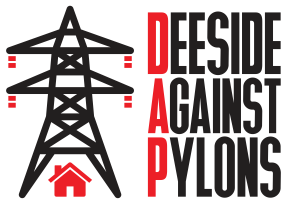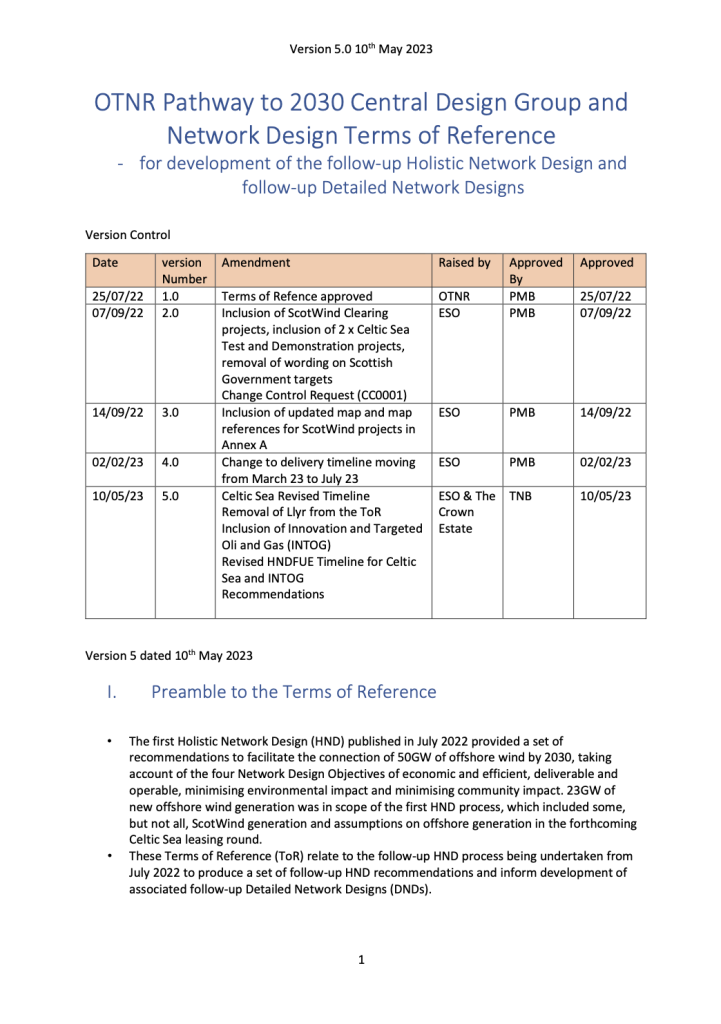Information

Ten things WRONG with SSEN’s proposal for the Kintore to Tealing Overhead Line (OHL) and its associated infrastructure, substations, access roads etc.
- We are being told the new onshore and offshore wind farms and associated power transmission lines are being built because Scotland needs the power. FALSE. The total potential generation capacity in Scotland is over 70 GW, almost eight times the predicted 2050 peak demand of 9.4GW.
- SSEN have told us that they were instructed to construct these new pylons by the National Grid Electricity System Operator. (ESO). FALSE. This is SSEN’s proposal, not anyone else’s.
3. SSEN have told us the scheme has been approved by OFGEM, the UK energy Regulator and the ESO. FALSE. The only approval required is that of the Scottish Government.
4. SSEN have told us these new lines were part of ESO’s UK wide 2022 Holistic Network Design. FALSE. The plan showed two major offshore transmission cables running subsea from Scotland to England and an upgrade to existing onshore pylons going south from Tealing. There was no mention of a new OHL with giant pylons.
5. SSEN have told us these overhead lines are being built in support of the Scottish Government’s decarbonised power generation aims and its 2045 Net Zero policy. FALSE. They are not required to achieve these aims.
6. SSEN have told us that pylons have no impact on house values. FALSE. Ask any Chartered Surveyor.
7. SSEN have told us there are no proven health impacts caused by electromagnetic forces from high voltage overhead lines. FALSE. This view is out of date. Recent studies show a significant increased risk to health.
8. The guidelines (National Policy Statement EN5) for building high voltage power lines talk about minimising the visual impact by screening them with trees or setting them against hills in the background. HOW? These pylons are 57 metres high on average with a maximum of 70 metres, higher than the tallest tree in the United Kingdom. Scots Pine average 25 metres. These monsters simply cannot be hidden.
9. In 2023 Aberdeenshire Council published their sensitivity analysis on the impact of wind farms on the landscape and have told us this also applies to tall pylons. They say “Introduction of towers within this height category could significantly erode the integrity of this well managed landscape”. For the area along the River Dee specifically, they say “Introduction of towers of this size could cause visual intrusion across the valley as seen from roads and settlements. The River Dee valley landscape is highly susceptible to change from this development type. The towers could visually dominate, and diminish the integrity of the undulating, wooded river valley.”
10. Are OHLs the only solution? NO. There are feasible alternatives to using steel lattice tower technology from the 1920s. By considering power transmission from Scotland to the south in an integrated way rather than in incremental sections, High Voltage DC technology can be used. This is the technology currently being used in western Europe. It can be buried out of sight, run subsea or be strung on existing pylons, all without impacting the landscape and our lives.
The only way to stop our landscape being ruined
and our lives upset is to object in writing.
Please attend the SSEN Consultations
It will need the maximum possible numbers of objections to have any impact.
Please get your friends, family, and neighbours involved.
WE CAN STOP THEM

“of what importance a family’s home
that stands in rich man’s way?”
From “The Highland Clearance” by Frank McNie
Our homes, our families, our countryside, our way of life all stand, right now, in the way of big corporations.
Scottish and Southern Energy Networks (SSEN) is a private company owned in part by a Canadian pension fund and by parent company Scottish and Southern Energy (SSE) which itself is owned by a variety of institutional investors. They exist to make money for their shareholders.
SSEN wants to erect, over the next four years, over 300 electricity pylons and associated substations in a line between Kintore and Tealing.
This is just part of a wider set of projects that will see around 1500 pylons the length of Scotland. These are not just any pylons – these are up to 70 metres in height. That is twice the height of Balmoral Castle and more than twice the height of any pylon you will currently see in the area. This represents the beginning of the industrialisation of rural Scotland and the destruction of landscapes that have provided habitat and beauty for generations. Ours is among the first communities to be devastated in this way but we won’t be the last. That is made clear in the recent publication by the National Grid, of “Beyond 2030” which lays bare the aspiration to give over the highlands and the east of Scotland to mass electricity infrastructure.
SSEN claims that this vandalism is mandated by the National Grid and the government energy regulator OFGEM. National Grid plc is also a private company that has wide interests across the US and UK. National Grid’s shareholders include global asset management firms and pension funds, notably those of Norway and the Abu Dhabi Investment Authority. They exist to make money for their shareholders.
These companies see massive profits to be made by building and operating this infrastructure. They seem not to care about our lives, our interests, climate change, social justice or Scotland.
We are supposed to be protected by the UK government energy regulator OFGEM. Their job is “to protect energy consumers, especially vulnerable people, by ensuring they are treated fairly and benefit from a cleaner, greener environment”. They are simply failing us.
Our best protection should come from our own Scottish Government. They are failing us. They too seem to be in thrall to the interests of big business. They have lost sight of the fact that they are only temporary custodians of a country that belongs to us all. A country that we, the people, want to pass on to future generations unspoiled and fit to meet their aspirations. Scottish Government talks about sustainable energy, about net zero and about energy security. But not for Scotland. Scotland doesn’t need this electricity. These pylons and lines are to transmit electricity from the north of Scotland to the south of the UK and beyond. It is all about money. If it were about Scotland, they would be planning for sustainable energy, produced locally, to be used locally. Their hubris has caused them to massively over-promise to private companies that want to build wind farms, without having anywhere near the infrastructure capacity to move all this electricity through Scotland on its way down south. They are now desperately trying to catch up, and see a solution in the quickly built, cheapest option that old technology represents. With UK and Scottish elections in the next two years our Scottish Government wants to avoid the accusation of yet another failure of a strategic infrastructure project. It is already too late, communities are finding them out.
We are finding them out in spite of their efforts to deflect and confuse. The national planning processes behind the proposals are opaque and complex. Different organisations hide behind each other to shift responsibility; frequently changing the names of plans and processes; vagueness and secrecy about cost benefit analysis; superficial and unconvincing analysis of the impact on the environment, communities and families – all features designed to keep ordinary people away.
We know that the new overhead line between Kintore and Tealing was not mandated by the national strategic plan. The first time it appeared in writing in the public domain was when SSEN started their public consultation on their plan. The new line is for their commercial benefit alone. They claim it is in support of the Scottish Government’s decarbonised power generation and Net Zero targets. They need to explain how importing 10,000 tonnes of steel from China, with an associated 25,000 tonnes of carbon dioxide, to build a system to export power to England and beyond contributes to Scotland’s targets.
The consultation SSEN have conducted locally has been patronising, unprofessional, partial and has failed to meet the Gunning Principles (1985) setting out the basic requirements of public consultation. All this hides behind fancy corporate documents and online presence that maybe convince regulators, and even win self-congratulatory industry awards, but fool not a single person living in our communities. The reality of their consultation is in the statement of a senior member of the SSEN team at one of their consultation events that “SSEN would drive this solution through irrespective of the universal negative feedback.” Presenting a proposal as a fait accompli is not a meaningful engagement with communities.
The community will not be made voiceless in this process. We will not stand by and acquiesce in the destruction because we are thrown the unconvincing scraps of “community benefit” or a few hundred pounds off our electricity bills.
To SSEN and the government, we will make our voice heard to tell you that what you plan will damage our health and that of our children. That the continued scientific research shows an association between EMF and leukaemia to the extent that the current Minister of State for Health and Secondary Care acknowledges that there is “uncertainty in the evidence” regarding the safety of pylons & our national health and that, as a consequence of this uncertainty, the government has agreed “precautionary measures”. The only precautionary measure that could stand scrutiny as proportionate to the risk is to ensure that overhead lines and pylons are not built anywhere near where our children live, play or go to school.
We will make our voice heard to tell you about the impact of your plans on farming – real people’s livelihoods and a direct impact on food security.
We will make our voice heard to tell you that your plan will damage the habitats of a variety of remarkable creatures and devastate the beauty of some of Scotland’s most wonderful landscapes. Not only from our windows but from everywhere for ever. We are ordinary
people trying to tread lightly on the earth that we are proud and privileged to inhabit. The King also has a home here, the late Queen took her last journey from Balmoral through Deeside, watched in wonder by the world. Visitors from around the world visit these landscapes, taking with them lifetime memories of a special place.
Nature Scot say “Tourism is one of seven growth industries in Scotland, contributing more than £4billion to our economy each year. The natural environment is a key tourism asset with our scenery and landscapes being the highest motivation for people to visit Scotland. Spending on nature-based tourism is estimated to contribute nearly 40% of all tourism spend, supporting 39,000full time equivalent jobs.”
You want to inflict a steel, concrete and wire gash through the middle of that same landscape.
We will make our voice heard to tell you that the technology you propose (ie pylons) is outdated. You need to go home and think again. Why should we accept a twentieth century solution to a twenty-first century challenge? By looking at the transmission section from Kintore to Tealing in isolation, instead of a whole system approach from the source of generation to your boundary with SPE and beyond, you have eliminated a range of modern options used by other countries with HVDC, whether offshore, buried onshore or by restringing existing infrastructure. In doing so you have come up with the crudest possible solution with huge and obtrusive lattice towers based on 1920’s technology.
We will make our voice heard to tell you that cost is not a good enough answer to our questions. Everyone in the UK will need to carry the costs of these plans, not only the few of us in rural Scottish communities unfortunate enough to be in its way. You have given cursory consideration to the engineering alternatives, often citing cost as an inhibiting factor. Your cost models are outdated and fail to incorporate the total costs, economic, environmental and social that our communities will bear disproportionately because you have taken the easiest route to profit.
We will make our voice heard to tell you that it is against natural justice to destroy the value in our homes by as much as 40 percent, if they are sellable at all. By doing so you are removing people’s right to make choices about their futures. You are taking away the means by which you expect us to fund our own social care when the time comes. We all accept that sometimes our individual interests come second to the needs of society as a whole but where a demand of this magnitude comes without any mitigating compensation, the contract between government and citizen is broken.
We will make our voice heard to tell you that the accumulation of these harms will have a profoundly negative impact on people’s mental health. The denial of agency and lack of meaningful response to our views is most potent in this regard. What you plan is already having a damaging impact on mental health, in so many ways, not least the prospect of living amongst the noise, dirt, traffic chaos and physical destruction of our land during the years it will take to deliver this project. We have a right to life and the protection of our private and family life. How, SSEN and our government, will you protect and promote these rights, and how will you respond to the concerns about mental health and welfare?
Deeside Against Pylons is part of the voice that is starting to swell and to resonate across the breadth and along the length of the United Kingdom. We see increasing evidence of what happens to ordinary citizens when government accepts at face value what it is told by commercial organisations and is unwilling to challenge and demand better on behalf of the people they serve.
We will use our voice to tell government that we elect you to serve our interests. To put yourself between us and harm. To protect and guarantee our human rights. To stand up to the rich man and say “you will have to find another way around this family’s home”.
Ours is not the only voice. Listen to the government itself;
“The Energy National Policy Statements (NPS) are badly out of date and offer little guidance as to national engineering and environment priorities and trade-offs. There is no long-term spatial plan to demonstrate the position and need for a new line within the integrated system. There is no agreed and public guidance as to how, where, and why lines should be onshore or offshore, overhead or underground, lattice pylons or novel designs. There is no agreed and public guidance on how system design should balance different environmental benefits and costs and how to trade-off global, national, regional, and local impacts. Is it so surprising that such alarm, emotion, and controversy is aroused by the schemes?”
UK Government Electricity Networks Commissioner, Nick Winser, June 2023
Scotland, surely, can do better.
Scotland, absolutely, has to do better.
Deeside Against Pylons
March 2024



